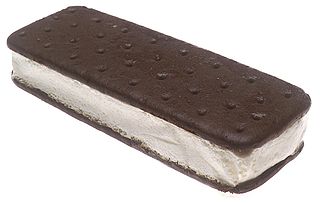
Ice cream is a frozen dessert typically made from milk or cream that has been flavoured with a sweetener, either sugar or an alternative, and a spice, such as cocoa or vanilla, or with fruit, such as strawberries or peaches. Food colouring is sometimes added in addition to stabilizers. The mixture is cooled below the freezing point of water and stirred to incorporate air spaces and prevent detectable ice crystals from forming. It can also be made by whisking a flavoured cream base and liquid nitrogen together. The result is a smooth, semi-solid foam that is solid at very low temperatures. It becomes more malleable as its temperature increases.

A lollipop is a type of sugar candy usually consisting of hard candy mounted on a stick and intended for sucking or licking. Different informal terms are used in different places, including lolly, sucker, sticky-pop, etc. Lollipops are available in many flavors and shapes.

An ice cream sandwich is a frozen dessert consisting of ice cream between two biscuits, wafers, soft cookies, or other baked goods. The ingredients are different around the world, with Ireland using wafers and the United States commonly using cookies.

A freezie or a freeze pop is a water-based frozen confection similar to an ice pop. It is made by freezing flavored liquid such as sugar water, fruit juice or purée inside a plastic casing or tube, either round or flat. Freezies come in sealed plastic tubular wrappers and conform to the shape of the wrapper when frozen to serve; as such, they do not need to be stored cold. They also do not need to be frozen as solidly as an ice pop and can have a consistency similar to that of a slushie. Freezies are sold in a variety of flavors, including cherry, orange, lemon-lime, watermelon, cream soda, blue raspberry and grape.

Popsicle is a Good Humor-Breyers brand of ice pop consisting of flavored, colored ice on a stick.

Byrsonima crassifolia is a species of flowering plant in the family Malpighiaceae, native to tropical America. Common names used in English include nance, maricao cimun, craboo, and golden spoon. In Jamaica it is called hogberry.

Sorbet is a frozen dessert made using ice combined with fruit juice, fruit purée, or other ingredients, such as wine, liqueur, or honey. Generally, sorbets do not contain dairy products.

Fla-Vor-Ice is the trademark name for a type of freezie. Unlike traditional popsicles, which include a wooden stick, Fla-Vor-Ice is sold in and eaten out of a plastic tube. Also unlike traditional popsicles, it is often sold in liquid form and requires the consumer to freeze the product at home. A vendor, though, may sell them frozen.
Paddle Pop is a brand of ice confection products originally created by Streets, which is now owned by the English-Dutch company Unilever. It is sold in Australia, New Zealand, and a few other countries. It is held for eating by a wooden stick which protrudes at the base. The brand has a mascot known as the Paddle Pop Lion, or Max, who appears on the product wrapper.

Frozen dessert is a dessert made by freezing liquids, semi-solids, and sometimes solids. They may be based on flavored water, on fruit purées, on milk and cream, on custard, on mousse (semifreddo), and others. It is sometimes sold as ice-cream in South Asia and other countries.

A screwball is a type of frozen confection that first appeared in the 1970s. It consists of ice cream inside a conical, plastic cup with a gumball at the bottom. The name was originally a commercial product name but is now used to describe all such ice cream treats.

Sorbetes is a traditional ice cream originating from the Philippines and uniquely characterized by the use of coconut milk and/or carabao milk. Often pejoratively called "dirty ice cream", it is distinct from the similarly named sorbet and sherbet. It is traditionally peddled in colorful wooden pushcarts by street vendors called "sorbeteros". It is served in various flavors in small wafer or sugar cones and more recently, as a pandesal bread ice cream sandwich.
Helados La Fresita is an ice cream pop and paleta manufacturer in Medellín, Colombia. The frozen treats are sold by vendors around the city and in surrounding areas. The logo is marked by a strawberry caricature. The company's motto is: An ice cream with all the fruit. Flavors include green mango, arequipe with raisins and coconut, coconut, lulo, peanut, guanabana (soursop), blackberry, strawberry, milk with raisins, and chocolate. The company also makes chocolate covered ice cream cones and ice cream sandwiches of various flavors, as well as fruit flavored ice pops, ice cream cups, and bulk ice cream boxes. The company was established in 1986.
La Michoacana is a group of different Mexican ice cream parlors, with an estimated 8 to 15 thousand locations in Mexico. The "chain" is a successful business model network of family-run businesses, no single company operates them as a formal franchise operation. In 1992 Alejandro Andrade and a group of enthusiastic ITESO students developed an image that would unify all La Michoacana parlors. And now it is an image that belongs to the entire town of Tocumbo. Paleterias bearing the name La Michoacana are also found throughout the United States, Central and South America.

Chamoyada is a sweet and spicy type of shaved ice, or raspado, drink prepared with fruit and flavored with chamoy. It is a part of Mexican cuisine, and is also common in regions of the United States with significant Mexican-American populations. The drink is most commonly prepared with mango sorbet or mango-flavored shaved ice, and thus is sometimes also called a mangonada or chamango.

Kulfi is a restaurant in Portland, Oregon. There have been two locations.















